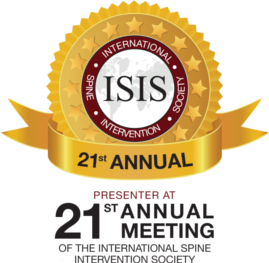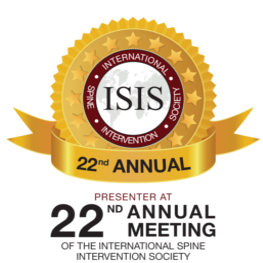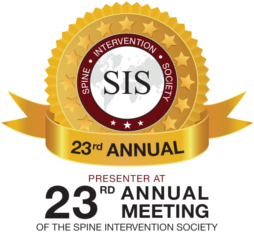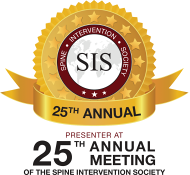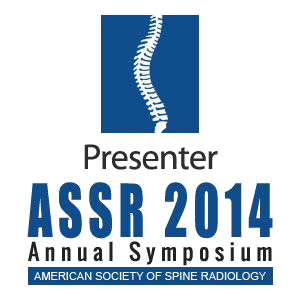A herniated disc can affect your quality of life and ability to move about. When a spinal disc's soft, creamy inner filling pushes through the defensive coating (often called a slipped or ruptured disc), it can impinge on surrounding nerves. Disc injury is common. Pain can be dull or sharp and may radiate to other body areas. Seeing the signs is important for diagnosis and management. Chronic back or neck pain or odd feelings in your limbs should not be overlooked. Knowing the crucial signs can help you ask for help to begin the road to relief. Here are eight herniated disc symptoms you should know.
Here are the herniated disc symptoms you should know.
Symptom 1: Neck, Lower Back, or Chest Pain
Back and neck pain will often mark the beginning of spinal problems. Sometimes, pain in the mid-back can occur. This can appear as pain or tightness in the chest. A problem with the spine, like a herniated disc or spinal stenosis, can lead to this pain.
When these issues progress, they can lead to nerve compression of the nerve roots. This is known as radiculopathy. This results in pain that travels away from the spine and down into a limb (leg or arm) along the nerve path. You could also experience numbness, tingling, or paresthesia, and muscle weakness in that area.
Myelopathy is a more serious condition related to spinal cord compression. This leads to neurological deficits like difficulty walking and maintaining balance, clumsiness of the hands, and stiffness.
Crucially, symptoms that warrant medical assessment urgently include:
- Saddle anesthesia, which refers to numbness experienced in the groin, buttocks, and perineum area
- Severe bowel or bladder activity dysfunction that is newly formed or worsens in severity
Symptom 2: Muscle Weakness
A compressed nerve due to a herniated disc could affect both sensation and motor nerve functions, causing muscle weakness. Signals from the nerve being compressed are sent from the brain to specific muscle cells to inform them when and how to contract. Disruption of this signaling can lead to weakness or delayed response of the muscle that the affected nerve supplies.
An example is ‘foot drop,’ in which it becomes hard to lift the front part of the foot, resulting in a higher risk of tripping.
A cervical herniation could result in weakness of the grip that makes it hard to hold objects or weakness of the arm that makes it hard to lift items. On the other hand, a lumbar herniation can make the leg feel like it gives way. You may experience problems like standing on your toes. This weakness of the muscles can significantly disrupt daily activities.
Symptom 3: Lumbar Radiculopathy
Lumbar radiculopathy is the irritation of the nerve root in the lower back due to compression. Sciatica is pain, weakness, or numbness affecting the leg or foot. True sciatica is technically a form of lumbar radiculopathy involving the sciatic nerve.
The defining symptom is pain that travels from the lower back to the leg. This pain travels below the knee and often goes as far as the foot and toes, following the nerve’s trajectory. Radicular pain is sharp, shooting, or electric-like as opposed to localized pain from the muscle.
Your leg or foot might feel weak, numb, or tingle (pins and needles), and hurt.
Foot drop means you cannot hold your foot up, especially while walking. The front part of the foot gets dragged down even while walking. These symptoms do not just cause discomfort. They could also indicate that a nerve is being compressed. Common causes include:
- A herniated or bulging disc, which presses on the nerve root
- Spinal stenosis or narrowing of the spinal canal
- Bone spurs or thickened ligaments
Symptom 4: Cervical Radiculopathy
Cervical radiculopathy is similar to lumbar radiculopathy, which affects the nerve root in the neck (the cervical spine) and irritates or compresses it. When this compression occurs, it can result in symptoms that extend to the upper body.
The main symptom is pain from the neck into the shoulder and the arm, possibly into the hand and fingers. The pain can range from mild to severe, but not too severe, and could feel like an aching, burning, or shooting sensation. The pain location and symptoms can indicate which nerve root is involved.
In addition to pain, a person with cervical radiculopathy could feel weakness, numbness, and tingling in the shoulder, arm, hand, or fingers. A common characteristic is muscle weakness in the arm or hand, leading to difficulty gripping or the inability to elevate or use the arm normally. Symptoms suggest a signaling issue coming from the cervical spine.
Common causes include herniated cervical discs, cervical spinal stenosis, and degenerative changes to the cervical vertebrae.
Symptom 5: Paresthesia
Paresthesia is the term for abnormal sensations, like tingling, prickling, burning, or feeling pins and needles. Most people would have experienced it temporarily, like their foot falling asleep due to pressure. If the ‘pins-and-needles’ sensation does not go away or comes back often, it may indicate damage or irritation to a nerve.
Chronic paresthesia hints more at a permanent issue and not a transient sensation. It can occur at various levels of the body and is a common symptom of radiculopathy (as discussed above) and myelopathy (as discussed below).
Diagnosis is required if you have persistent paresthesia. It is a sensory disturbance that disrupts the normal pathway of the nervous system. This disruption is usually dysfunctional and should not be neglected.
Symptom 6: Myelopathy
Myelopathy refers to the spinal cord compression and not the nerve roots. There could be compression in different spine regions, like the neck and mid-back. However, the spinal cord generally does not continue into the lumbar lower back area.
The symptoms of myelopathy often reflect a generalized dysfunction of the nervous system because of spinal cord compromise. Signs of a condition that may direct the doctor to a neurological condition include altered gait. Your hands could also have fine motor skill problems, which, combined with the above symptoms, cause a feeling of unsteadiness. As a result, you will have difficulty buttoning clothes or handwriting problems.
Numbness, weakness, or altered limb sensation could occur below the compression level. Muscle tone and stiffness of legs, which is known as spasticity, also exaggerated reflexes, and that is called hyperreflexia. This is a classic sign of injury to the upper motor neuron because of the pressure over the spinal cord. People sometimes experience a sensation resembling an electrical shock on flexion at the neck. This is called Lhermitte’s sign. The sensation travels down the spine up to the limbs.
Advanced myelopathy can also affect bowel and bladder function. Myelopathy is progressive, and early diagnosis and management are vital to avoid permanent neurological deficits.
Symptom 7: Saddle Anesthesia
Saddle anesthesia is a vital symptom where one loses the sensation in the area that would be in contact with a saddle when riding a horse. This also includes the perineum, that is, the area between the anus and the genitals.
The presence of saddle anesthesia is a key symptom of Cauda Equina Syndrome (CES). CES is a serious but highly rare condition caused by compression of the mass of nerves in the lower end of the spinal cord called the cauda equina. This compression disrupts the functioning of the pelvic organs and lower extremities.
Saddle anesthesia shows that these essential nerve roots have been seriously compromised and is a medical emergency. People with this symptom, especially those with back pain, should be evaluated by a physician urgently to avoid permanent nerve compromise.
Symptom 8: Incontinent Bowel or Bladder
Another symptom is a new onset or worsening difficulty in controlling bowel or bladder function, which could indicate severe compression of the spinal cord or cauda equina. This dysfunction can manifest in several ways.
Some people could:
- Have trouble starting to urinate, urinary retention
- Not completely emptying the bladder
- Lose control over the bladder, urinary incontinence, potentially not feeling the urge to go
Like the bladder, bowel function could also be impacted, making it hard for bowel movement.
Treating a Herniated Disc
A herniated disc, sometimes called a slipped or ruptured disc, occurs when the gel-like center of a spinal disc pushes through a tear in the tougher exterior of the disc. The discs cushion the spine’s vertebrae and, when injured, can compress an adjacent nerve root and, in extreme cases, the spinal cord. All this could lead to several symptoms, notably pain. Knowing how to treat or, more importantly, how to prevent one from developing will be important in the long run.
The main goal of herniated disc treatment is to relieve pain and other symptoms, promote healing, and restore function. Most herniated discs do not require surgery. They respond well to conservative, non-surgical treatment. The body is capable of healing itself. Therefore, the initial aim of the treatment is to put the body in a position to recover the nerve while also addressing the pain and other neurological symptoms caused by the compressed nerve.
Some of the methods that can help treat herniated discs include:
Resting
Usually, rest is the first line of treatment for a herniated disc or an alteration of activity. This does not necessarily mean bed rest, which can be counterproductive. Instead, it involves a temporary restriction of aggravating activities, like lifting too heavy, repetitively bending, twisting, or sitting or standing in awkward positions for too long. You can engage in gentle movement, like a short walk, to help with circulation. This period will allow inflammation to subside and the injured disc to begin healing without being reinjured.
Pain Management
Relieving pain is also an immediate focus. You can alleviate pain and discomfort by moving freely and engaging in rehabilitation exercises. Your doctor could also recommend over-the-counter drugs like ibuprofen or naproxen (NSAIDs), which can help reduce pain and inflammation of the affected nerve.
If the over-the-counter options are insufficient, your doctor could prescribe stronger drugs or muscle relaxants. They may help break the pain and muscle spasm cycle. Use these meds as per recommended dosages and keep a check on side effects.
Physical Therapy
Physical therapy is another important form of conservative treatment essential for a herniated disc. A physical therapist will assess your pain and other limitations to create a program specific to your needs.
The purpose of physical therapy can be for:
- Pain relief
- Enhancement of spinal mobility and range of motion
- Strengthening spinal support muscles, especially the core and back extensor muscles
- Teaching the patient the fundamentals of body mechanics and posture
The scope of physiotherapy might include:
- Gentle aerobics, along with some measures like stretching and strengthening exercises
- Manual therapy and other techniques like application of heat, ice,
- Electric stimulation to relieve pain and relax muscles
Spinal Injections
When oral medicine and physical therapy do not adequately manage nerve pain, the doctor could consider injection therapy. An epidural steroid injection is a standard option. The injection contains steroid medication directed at the epidural space. It is a standard option for people with back pain. The steroid helps lessen some irritation around the crushed nerve to relieve pain. However, the relief may only be temporary.
Spinal injections are a quick relief option that allows the patient to participate in physical therapy. They can also work on strengthening their back. Likewise, the relief may last longer. It will also help them improve functionality.
Surgery
Though most people can find relief through conservative treatments, surgery may be the best option when non-surgical treatment fails to provide sufficient relief over time (usually months), or if there is significant nerve compression or neurological deficit. Severe or advancing weakness or numbness, as well as changes to bowel or bladder function (medical emergencies), are signs that surgery is likely needed relatively soon to avoid permanent nerve damage. Your spine specialist will help you proceed with the surgery after weighing the suitability of symptoms against the potential benefits and risks of the surgical procedure.
The procedure done most often for a herniated disc causing radiculopathy is a microdiscectomy. Usually, this type of procedure is done via a small incision. With a microscope or endoscope, the surgeon will remove only the part of your herniated disc pressing on the nerve root. This seeks to relieve the pressure from the nerve so the radiating pain can lessen, and nerve function could return.
In most cases, recovery takes less time than extensive spine surgeries. Furthermore, the surgeon could recommend physical therapy after the procedure to help gain strength and mobility.
There are other surgical options depending on the specific situation, such as:
- Laminectomy or laminotomy to create more space
- Fusion for more complex procedures and artificial disc replacement in specific degenerative cases
Tips to Prevent a Herniated Disc
Going from treatment to prevention, age and genetic makeup do play a role in developing herniated discs. However, most of the risk factors are either lifestyle-related or characteristics that can be modified. There are steps you can take that will help reduce your chances of having a herniated disc or help manage if you already have one. These include the following:
Maintain a Healthy Weight
Keeping your body weight in check is the first step to spinal health. When you struggle with a lot of weight, the extra weight around the abdomen causes stress on the lumbar and lower back discs. Through proper dieting and exercising, you can manage your weight so that the load the spine has to support is decreased, thus taking pressure off the discs and helping reduce the chance of herniation.
Practice Good Posture
You should sit and stand in the correct posture. Over time, bad posture can move the spine out of its proper alignment and pressure the discs. When sitting, ensure your back is supported, your feet are flat on the floor, and your shoulders are relaxed. Try to keep your body weight evenly dispersed on both your feet.
Being mindful of your posture daily helps the spine maintain its natural curves and allows a more even repartition of load on the discs.
Master Proper Lifting Techniques
Preventing herniated discs is all about proper lifting techniques. Many people hurt their backs by lifting incorrectly. When lifting things, always bend your knees and keep your back straight. Lift with your legs. Hold the object close to your body while moving to avoid spine strain. Avoid twisting while lifting. If an object is too heavy, get help. How you lift objects significantly affects the pressure on your discs.
Engage in Regular Exercise
Regular exercise is indispensable for spinal health. Strengthening the core, abdomen, back, and pelvis can support the spine like a natural back brace. Doing exercises to help keep the back, hips, and spine flexible can reduce stiffness and keep the spine mobile. It helps to keep walking, swimming, or cycling, as these are good aerobic exercises that help with circulation and overall fitness.
A consistent exercise routine builds the ability to make your spine strong and flexible, which can help protect the spine throughout the day.
Optimize Your Ergonomics
If you focus on ergonomics in your workplace and home, it can prevent disc issues. Ensure that your desk chair supports your lower back and is at a height where your feet can rest flat. Position your computer monitor at eye level to avoid straining your neck. Stand up and stretch if you have to sit or stand for a long time at work. Minor environmental adjustments can make a big difference in reducing chronic strain on your spine.
Avoid Smoking and Remain Hydrated
Avoid smoking cigarettes and drink enough fluids to stay hydrated. Smoking is damaging to your spine because it restricts blood oxygen to the discs. The discs are crucial because they give the spine flexibility. Keeping hydrated gives your discs enough fluid to become tough and act like a cushion.
Listen to Your Body's Signals
Listen to your body. Do not ignore early signs of back or neck pain. If you deal with your pain or stiffness early, a minor issue will not progress to a herniated disc. See your doctor if you have constant or increasing pain or any signs of nerve symptoms.
Find a Spine Specialist Near Me
Be careful not to develop a herniated disc. It could lead to pain and make you unable to move. When you know what signs to look out for, you will be better positioned to address the problem early enough. Disregarding the pain, numbness, weakness, or other red flags could worsen the situation, and your quality of life will diminish. Caring for your spine is vital for living a full, active life.
If you experience any of these symptoms, you should consult a professional. Acting promptly is the best way to obtain relief and prevent complications. Contact the Los Angeles spinal experts at LAMIS (Los Angeles Minimally Invasive Spine) Institute for an evaluation and treatment plan tailored to your needs. Contact us at 310-734-6088.

